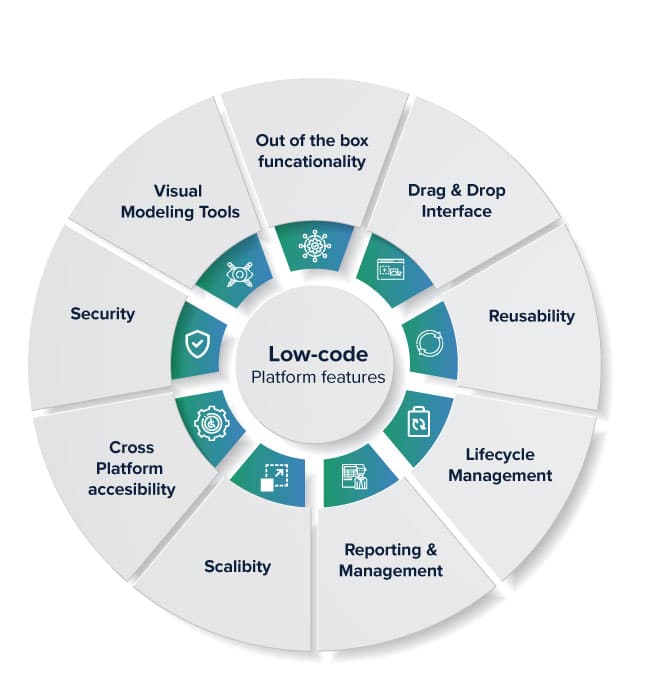Excellent Ideas On Selecting Low-code platforms for application development
Excellent Ideas On Selecting Low-code platforms for application development
Blog Article
Advantages Of Low-Code Application Development In Terms Of Accessibility To Non-Developers
The following main factors make low-code programming accessible to those who are not developers.
Drag-and–Drop Builders : Low-code platforms offer drag-and–drop interfaces which enable non-developers, who do not need to write code, to build visually appealing applications. This makes the process of developing easier for those with no technical backgrounds.
WYSIWYG Editors: "What You See Is What You Get" editors allow users to build interfaces and workflows the same way as the final product, making it easier to use and understand.
Simplified workflow and logic
Visual Workflow Modeling: Users can develop business processes and apply logic by using visual flowcharts or models that are more intuitive than the traditional methods of coding.
Pre-built Components of Logic: Low-code platforms often come with pre-built logic (e.g. loops or conditional statements) that are easily adjusted, thus reducing the requirement for complicated programming.
Reusable Components and Templates
Libraries of pre-built templates: A lot of low-code platforms provide a library of templates for the most common types of applications, enabling non-developers to start with a solid foundation to modify as they need to.
Reusable modules and widgets: The development of web pages is made simpler by using reusable components and modules. This reduces the need for deep technical knowledge.
Guided Development and Tutorials:
Step-by-Step guide: Platforms provide tutorials and online assistance to non-developers who are building applications.
Interactive Tutorials. Interactive, hands-on tutorials allow users to learn through doing.
Integration with an existing tool:
Easy Integration - Low-code platforms can be easily integrated with existing systems and business tools (e.g. ERP CRM, ERP), allowing even non-developers the ability to build apps that are compatible within their workflows.
APIs/Connectors: The built-in APIs/connectors enable non-developers to connect their applications to external services.
Collaboration Features:
Team Collaboration: Features like real-time collaborative workspaces, as well as shared workspaces make it possible for non-developers to effectively collaborate with business analysts, developers and other users.
Access control based on role: Role levels are able to be set for non-developers to make sure they are able to contribute to development without compromising the security.
Automated Testing & Debugging
Low-code platforms are usually equipped with testing and debugging software that can automatize these procedures. This makes it simpler for non-developers to ensure that the functionality of their apps.
Error Highlighting: Whenever issues arise the platform flags the errors and suggests solutions and guides non-developers through troubleshooting procedures.
The main benefit of developing applications using low-code in terms of accessibility to non-developers stems due to its ability to decentralize the development process. Low-code platforms allow business users to participate actively in the development and maintenance of applications by providing intuitive visual tools as well as a guiding experience. This bridges the gap between technical implementation and business demands. Have a look at the most popular Low-code Platform for application development url for blog advice including develop web app, rapid application design, app modernisation, rapid applications, push notifications, microsoft azure sql, azure sql, application development platforms, rapid app development, cross platform mobile dev and more.
The Low-Cost Of Development Is One Of The Primary Benefits.
Low-code development of applications offers a variety of benefits in terms of cost-efficiency and efficiency, which makes it an appealing option for businesses looking to optimize their development budgets while still delivering top-quality software. These are the major benefits reduced costs for development:
Lower Coding Requirement: Lower programming platforms eliminate the need to write code manually which saves developers time as well as money. This also results in lower costs for labor.
Fewer Developer Resources: Since low-code development is more efficient and easier, fewer developers are required. This can cut down on hiring and staffing costs.
More Time to Market
Accelerated development cycle Visual development tools and pre-built components that are provided by low-code platforms enable rapid development of applications. This allows companies to bring their products market quicker. This could result in faster revenue generation and better positioning in the market.
Rapid Prototyping. Businesses can rapidly test and build prototypes. This cuts down time during the development phase and permits quicker iterations built on feedback from users.
Low Maintenance Costs
The modular architecture and standardized components of apps developed using low-code platforms make them easier to maintain. This helps reduce the cost of ongoing maintenance.
Automated Updates: Many low-code platforms can handle patches and updates automatically and ensure that applications are secure and up-to-date, without the need for extensive manual intervention.
Efficient Resource Utilization:
Non-Developer contributions: Low code platforms allow non-developers, like business users, to contribute to the process of development. This democratization of the development process permits firms to make use of the skills and talents of a wider variety of employees.
IT Departments can Focus on Strategic Initiatives: Instead of getting overwhelmed by the daily work, IT departments can concentrate their efforts on strategic initiatives to increase the efficiency and productivity of their departments.
The Scalable Pricing model
Subscription pricing: A lot of low-code platforms offer different subscription pricing options that can be scaled according to usage. Businesses are able to adjust their spending in line with their growth and needs, without incurring large upfront costs.
Pay-As-You-Go: A few platforms offer pay-as you-go options. This allows businesses to only pay for resources that they actually need. This is especially useful for startups and small-sized businesses with limited budgets.
Costs for reduced Third-Party Software:
Built-in Functionalities: Low-code systems often come with built-in functionalities and integrations that reduce the requirement for third-party tools and software, resulting in cost savings on software licensing and subscription costs.
Pre-Built Integrations: The accessibility and pre-built integrations with popular services and system minimizes the need for custom development and can save time and money.
Improved ROI:
Faster Return On Investment: A combination of rapid development and lower expenses with speedier time to market allows businesses to get a greater return on their investment.
Increased Agility: Businesses are able to quickly adapt to changes in the market and demands of their customers and ensure that they remain current and take advantage of emerging opportunities when they occur.
Lower Training Costs:
User-friendly interfaces: Low-code systems offer user-friendly and intuitive interfaces that cut down on the learning curve. They also reduce the requirement for lengthy courses of instruction.
Accessible resources: Many low-code platforms have extensive tutorials, training materials, and community assistance, reducing the requirement for formal education.
Collaboration can be streamlined.
Enhanced Collaboration Tool: The built-in collaboration tool facilitates better communication and cooperation among team members. This results in more efficient development processes, and also reduces the cost of projects.
Unified Development Environment (UDE): A single, unifying development environment that streamlines workflows and reduces cost and complexity that comes with managing different tools and platforms.
The cost-effectiveness in low-code app development lies in its ability to reduce maintenance and development costs, accelerate the time to market, maximize resources, and also offer different pricing options. All of these factors provide substantial financial benefits to businesses which makes low-code an attractive choice for organizations aiming to increase their budgets for development and create solid, scalable and top-quality applications. Check out the best more helpful hints about Legacy application modernization with Low-code for more recommendations including cross platform app dev, develop web app, application development platforms, low code platforms, build with docker, push notifications android, push notifications android, lowcode no code, rad development, application modernization and more.
Low-Code Apps Can Provide Benefits For Collaboration And Workflow
The low-code approach to application development offers a variety of advantages in terms of collaboration and workflow and collaboration, making it a fantastic choice for companies seeking to increase team efficiency and streamline their development processes. These are the primary benefits.
Unified Development Environment: Low-code platforms offer a unified, single environment where team members such as business analysts, developers designers, and other stakeholders can work efficiently. This reduces barriers and improve communication.
Visual Development The platform's visual drag-and-drop capabilities make it simple for nontechnical team participants to be involved to the design process. It also ensures that business requirements are captured correctly and then implemented.
Communication Enhanced:
Real-Time Collaboration A number of low-code platforms include real-time features, such as editing and commenting simultaneously, or immediate feedback. This enables constant communication and can help reduce the time that is spent in back-and forth discussions.
Workspaces shared by teams. Teams can collaborate in shared workspaces. In this workspace, they can review, edit, and discuss various project components.
The management of workflows has been simplified
Built-in tools for managing projects Lowcode platforms are often equipped with integrated tools that assist teams in preparing, tracking and directing their growth. This includes assigning tasks, tracking progress, and managing deadlines.
Automating routine workflows and activities decreases errors and manual work that allows individuals and teams to focus more on important initiatives and boost efficiency.
More efficient Iteration cycles
Rapid Prototyping: Low-code platforms enable rapid prototyping. They also permit rapid and iterative development. This allows teams to develop apps, test them and refine them within a shorter period of time. This allows feedback to be quickly integrated and changes are made.
Support for Agile Methodologies Using agile practices gives teams the ability to run sprints and continually deliver small amounts of functionality which makes it simpler to adjust to changing requirements.
Accessibility for Non-Developers:
Citizen Development: Low-code platforms allow users in the business (citizen developers) to create and modify applications with no coding expertise. This lets IT and development teams to concentrate on other areas and respond faster to business requirements.
Training and Onboarding. The user-friendly interfaces of training tools allow new members to get acquainted with the system and this enhances teamwork.
Centralized documentation, knowledge sharing and dissemination:
Integrated documentation Platform features that are low-code usually allow you to make and manage documents inside the platform. All information about your project will be centralized and easily accessible.
Knowledge Repositories. Teams can create and manage knowledge repositories that contain best practices templates as well as a reuseable components, making it easier for knowledge exchange and reducing the amount of duplicate work.
Consistency Standards, Standardization and Consistency:
Standardized Components : The use pre-built, standardized components provides an enduring consistency across applications. It makes it simpler for team members to understand different parts of a given project and then work on them.
Governance and Compliance - Built-in governance frameworks make sure that the creation of every application follows organizational standards as well as regulatory guidelines. This reduces the risk of non-compliance and ensures that the application is compliant with high-quality standards.
Feedback loops:
Integrated Feedback Systems: Low-code platforms provide integrated feedback systems that enable users to give feedback to the applications. The feedback can then be used in the development of the applications.
Continuous Improvement: The ability of quickly iterating and deploying changes based upon feedback ensures that applications are constantly enhanced, and are in line with the goals and needs of users.
Visualization, Reporting and Analysis
Real-Time Analysis: Analytics and reporting tools integrated into the software give real-time information on the progress of projects, user interaction and performance. This enables an informed decision-making process based on data.
Visual Workflow Analysis Visual tools are used to map processes and workflows. These tools assist teams determine and improve their workflows.
When it comes to collaboration, low-code apps are a great way to streamline workflows, bring teams from different backgrounds together and streamline tasks. This creates a more flexible, efficient and collaborative environment for development. This eventually results in better-quality applications as well as better alignment of business goals.